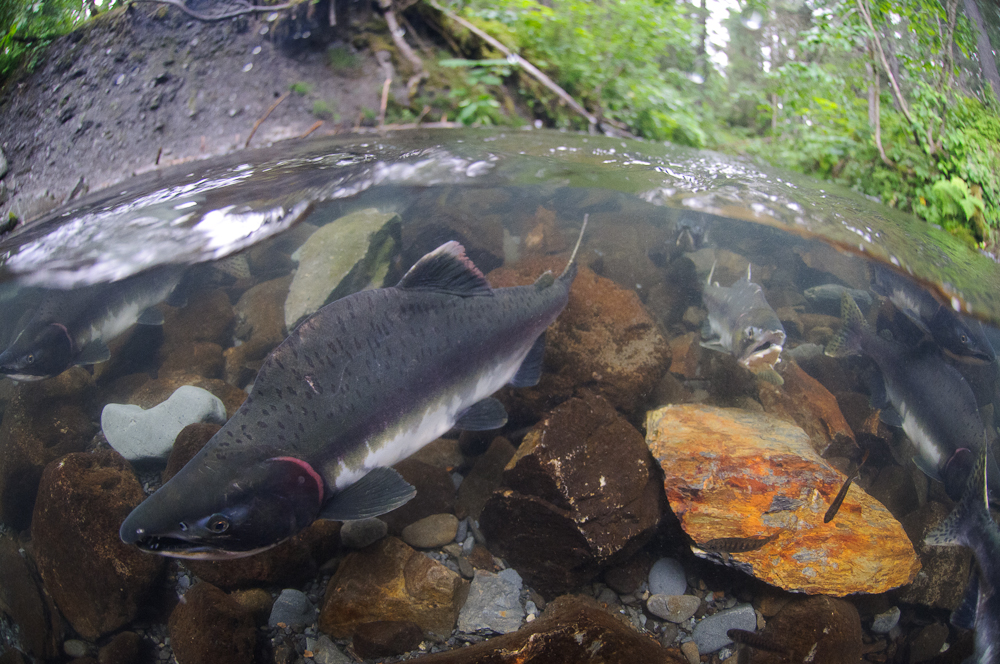Warming conditions are making northern Bering Sea more friendly for pink salmon
The fish are among several boreal species moving into Arctic habitats.

Pink salmon, the most plentiful and cheapest of Alaska’s five salmon species, are finding more hospitable habitat in the warming northern Bering Sea, a new study finds.
There is a clear link between warming temperatures at Nome and better juvenile salmon productivity in rivers that flow into the northern Bering Sea, said the study, published in the journal Deep Sea Research Part II: Topical Studies in Oceanography.
Pink salmon, a species more associated with waters off Alaska’s southern coast, appear to be among those boreal species working their way into more northern waters in response to climate change.
Pink salmon’s short life cycle makes their population more adaptable to these changes in environmental conditions, according to the study. Other salmon species spend up to seven years at sea before returning to freshwater to spawn, but pink salmon have a total life cycle of only two years — counting their time in both saltwater and freshwater — and that relatively quick turnaround gives more chances for succeeding generations to shift their migration patterns.
“Pink salmon are definitely good at straying,” said lead author Ed Farley of the National Oceanic and Atmospheric Administration. “They definitely want to go seek out other habitat.”
[Pink salmon catches in Nunavik are raising red flags for biologists]
The straying extends beyond the northern Bering. Pink salmon are becoming more plentiful in farther-north waters, spreading in noticeable ways eastward in the Arctic Ocean.
“Every year, they’re catching pinks and chums in the Canadian Beaufort,” said Farley, who works at NOAA’s Alaska Fisheries Science Center.
Yet to be determined is whether the pink salmon are becoming permanently established that Far North, he said. “That’s the next stage — when will pink salmon be able to spawn successfully, and are they doing that now?” he said.
Pacific pink salmon have even been found on the Atlantic side of the Arctic, in waters of Quebec’s Nunavik region, raising concerns because they are considered invasive there.
For the northern Bering Sea, the onslaught of pink salmon comes amid a wider shuffling of the ecosystem as temperatures warm and ice retreats.
Along with pink salmon, lower-fat boreal species like Pacific cod and pollock moving into territory that used to be dominated by higher-fat far-north species such as Arctic cod. This year, Russian authorities opened the first-ever commercial pollock fishery in the Chukchi Sea.
Ocean conditions have shifted dramatically in the Bering. In 2018, the Bering had lower ice levels than at any time in the past 5,500 years, according to a study that analyzed isotopes found in peat sampled from uninhabited St. Matthew Island. The chemical fingerprints of oxygen molecules in the peat showed the differences between high-ice seasons with northern weather influences and low-ice seasons with weather influences from the south, according to the study, published in the journal Scientific Advances.
[A radical transformation of the Pacific Arctic appears to be underway, a new study finds]
The 2018 ice results suggest that future Bering Sea ice scarcity will be even more drastic, said lead author Miriam Jones of the U.S. Geological Survey. The results point to that year’s ultra-low ice being a product of decades-ago carbon emissions, Jones said
“If that lag exists, it suggests that, essentially, the Bering Sea is responding to contents of atmospheric CO2 from previous decades,” she said.
While weather and air temperature changes can happen pretty quickly, the heating of the ocean is a much slower process, she said.
“The ocean, obviously, is not just a flat surface. It’s three-dimensional,” she said. “There’s surface currents that are changing and deeper currents that are changing and deeper water that’s warming.”
If future conditions indeed bring more pink salmon to the northern Bering Sea, is that a good or bad thing? The study sidesteps the question, and Farley said he doesn’t know the answer.
“That’s hard to say for me. I’m not sure what it means for the communities that live there,” he said.
But Farley, who lives in Juneau and visits a regular camping spot where he and his family fish, is fond of the species himself. “I like pink salmon,” he said. “We enjoy them. We eat them. We smoke them.
So far, fish processors operating in the northern Bering Sea do not seem to share his enthusiasm.
Large amounts of pink salmon Big runs recorded, but not much harvested, said Jim Menard, lead biologist for the Alaska Department of Fish and Game in Nome.
Even though pink numbers have “shot up” in recent year, fishermen have not switched to harvesting large numbers of them, said Jim Menard, the Alaska Department of Fish and Game area biologist for Nome.
“They’re not adjusting fishing effort because the buyers are not interested in pinks,” Menard said.
Nome commercial fishermen have focused their harvests much more on silver salmon, also known as cohos, and chum salmon, according to state records.
Pink salmon usually fetch much lower prices for fishermen than the other salmon species. Last year in Norton Sound, for example, processors paid $13 cents a pound for pinks in Norton Sound, compared to $1.57 a pound for coho salmon, according to the Alaska Department of Fish and Game 2019 summary.
Even sport fishermen in Nome are generally bypassing the plentiful pink salmon in favor of different salmon species, Menard said.
“Mostly, they want to go to the Pilgrim River for sockeye,” he said.